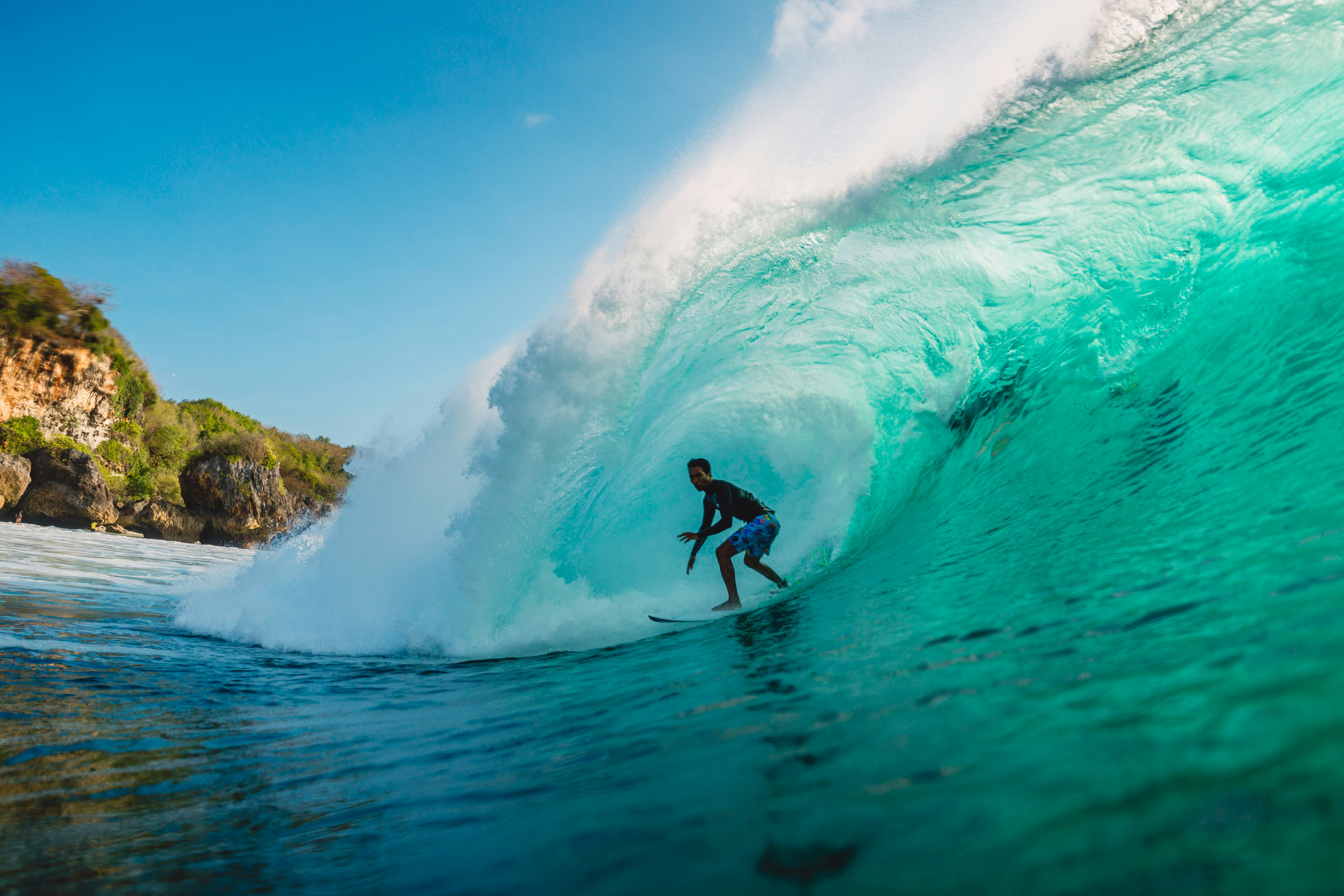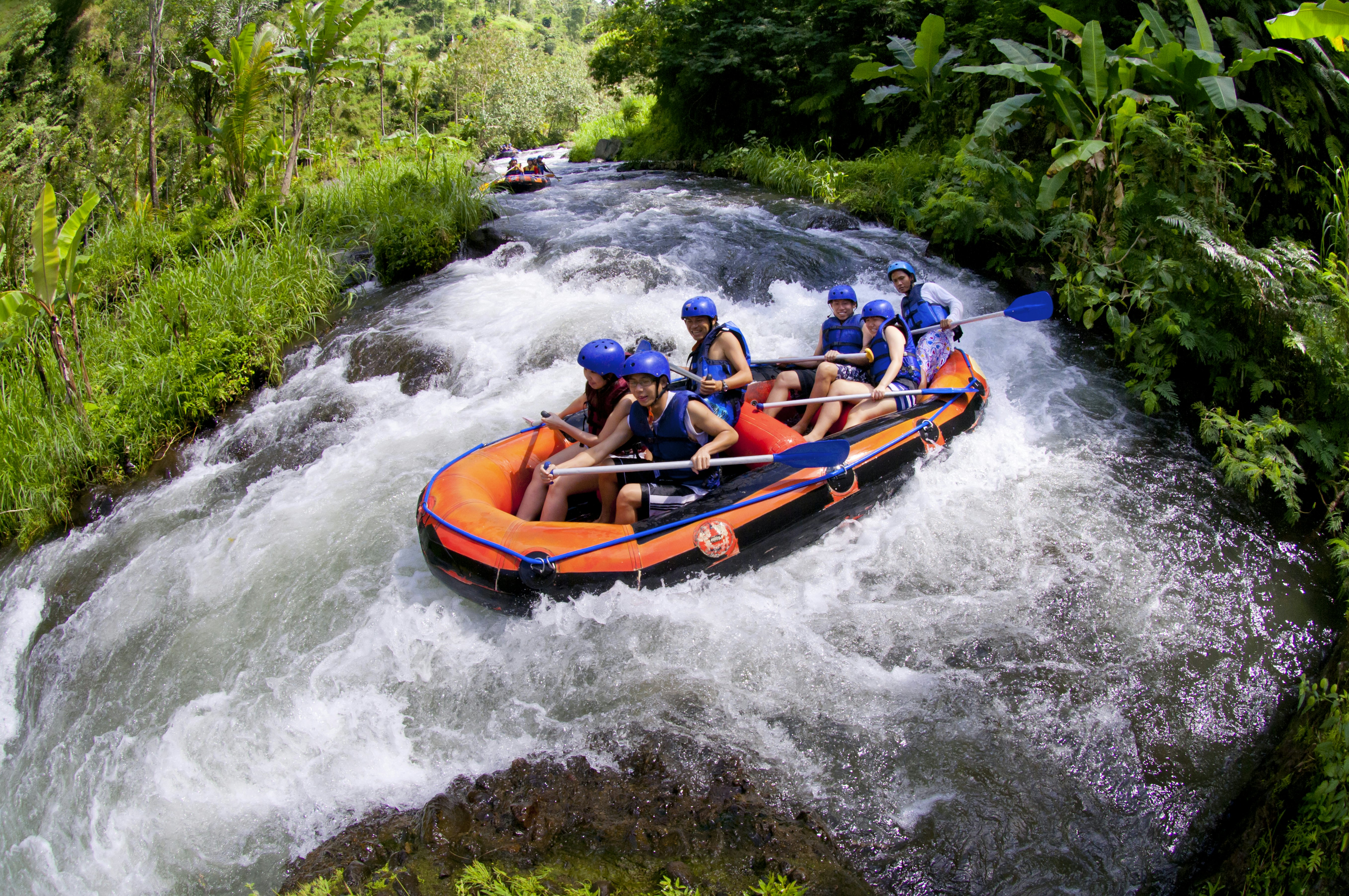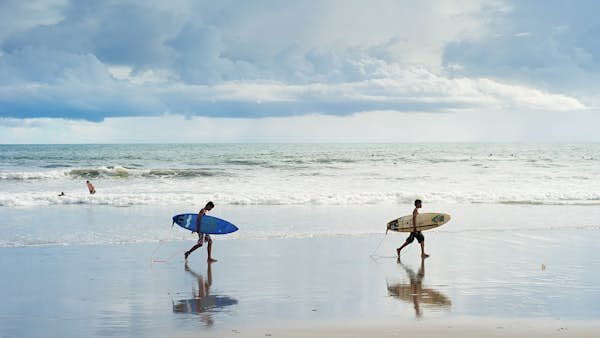Bali lives large in travelers’ dreams for good reason.
The Indonesian island has a unique Hindu culture that sets it apart in a huge, majority-Muslim nation. Its dramatic tropical landscapes and shorelines cater to those who like to surf, practice yoga, trek on volcanoes, dive pristine reefs or go white-water rafting. And Bali’s long tradition of hospitality means visitors are made to feel most welcome, whether in small villages or at luxurious spas.
Where to even begin on the “island of the gods”? Consider our list of the top 11 things to do in Bali.
Advertisement

1. Photograph Southeast Asia’s most colorful traditional fishing fleet
The fleet of selerek (traditional Balinese fishing boats) at Perancak inlet provides one of the most delightful – and least known – sights on the entire island. These vibrantly colorful longboats, with curiously decorated crow’s nests (many shaped like chariots) and long-tail engines spiking out from their hulls, will amaze any visitor who takes the trouble to reach this unspoiled corner of West Bali.
2. Discover Bali’s underwater splendors
Lying at the center of the Coral Triangle, Indonesia boasts some of the richest marine habitats on the planet, which means Bali has its share of top diving and snorkeling spots. In fact, the entire north coast – which is spared the lashing waves of the south – is a watery wonderland for snorkelers and scuba divers. The island of Nusa Lembongan is a good place to start; Bali Hai runs diving day trips to “Manta Alley” and other local sites, as well as full PADI-certification courses.
Off Bali’s northwest tip, Menjangan Island also has world-class diving – without crowds. You’ll see the entire spectrum of reef fish alongside turtles, reef sharks, and (if you’re lucky) dolphins and whale sharks. The Menjangan resort rents kayaks and can arrange guided diving and snorkeling trips to the island.

3. Stroll across the emerald expanses of the Jatiluwih Rice Terraces
Lying just 9⅓ miles (15km) north of Ubud, the pretty rice terraces of Tegallalang are a prime tourist destination. Yet with each passing year, the area gets more and more developed. And it’s hard to soak up the beauty of the valley with all the noise from honking tour buses, especially at sunset.
For a better introduction to the great paddy landscapes that cover less-visited parts of Bali, head for the immense Jatiluwih terraces, around 25 miles (40km) northwest. This idyllic stretch of countryside is perfect for wandering alone; you might also consider hiring a local guide if you want to understand the intricacies of the 1000-year-old subak (irrigation) system, which is inscribed on UNESCO’s cultural-heritage list.
4. Pamper yourself at a holistic spa
Whether you choose to bliss out with an après-surf massage on the beach or have a marathon all-day pampering session in a five-star spa, Bali takes vacation relaxation to the next level.
Four Seasons Resort Bali at Sayan and Fivelements Retreat near Ubud are open to non-guests – and rank among the best spa and wellness retreats I’ve been to. The Sacred River Spa at the Four Seasons has it all: spa treatments, traditional healers and chakra ceremonies in spellbinding surroundings overlooking the Ayung Valley. Fivelements specializes in holistic treatments inspired by Balinese traditions, with a focus on plant-based cuisine, sacred arts and romantic day experiences that are perfect for couples. Both spots also offer yoga and other wellness packages.
The massages and beauty treatments at Glo attract plenty of repeat visitors. If you’re traveling on a budget, head to one of the Yes Spa Bali establishments in Kuta or Legian, where you can enjoy excellent traditional Balinese massages for under US$10.

5. Grab a surfboard and catch the Bali pipeline
Bali is a world-class destination for surfers. While the island is legendary for waves such as Uluwatu, Padang Padang (the “Balinese Pipeline”) and the aptly named Impossibles, countless other spots are perfect for intermediate surfers or beginners.
Advertisement
Canggu and Kuta Beach are the best hubs on the island for novice surfers. Canggu has plenty of board-rental stands and surf schools offering lessons; check out Echo Beach for relatively mellow waves where you can find your feet. More board-rental places and surf schools can be found along Kuta Beach, and the waves here are even more suited for those getting the hang of things – most of the time, that is. Many beginners find out the hard way that high tide at Kuta brings steep, heavy shore-breakers that often challenge even experienced surfers. Aim to have your lessons close to low tide, and save the tougher waves for later in your surfing career.
If you’d rather escape the crowds, Medewi in West Bali is one of Bali’s lesser-visited spots for good waves. The point itself is covered in boulders, making it best for intermediate or experienced surfers – but you’ll find 10km (6¼ miles) of sandy-bottom beach breaks on either side of Medewi that are blissfully empty.

6. Climb up Batur volcano at sunrise
The 5633ft (1717m) summit of the Batur volcano is perhaps the best place to take in the sunrise on an island that Indian statesman Jawaharlal Nehru called the “morning of the world.” From the crater rim, the view takes in Mt Agung – the island’s highest peak and the spiritual abode of the gods in Balinese culture – and Mt Rinjani on distant Lombok.
You’ll have to set your alarm incredibly early to witness the splendor. Most tours start with a hotel pickup between 1am and 2am so hikers can complete the 2¼-mile (3½km) trek and arrive at the summit by sunrise.

7. Tour the Ayung Valley by raft
Jungle rivers cascade down from the volcanic highlands in the center of Bali, carving great ravines that are some of the most dramatic features of the island’s geography. The southern hills teem with these rivers, and rafting is often the best way to experience these still-unspoiled jungle canyons.
Bali’s rivers may not offer pulse-raising rapids – but what you lose in adrenaline, you gain in the sheer pleasure of seeing the Ubud area from a totally unexpected angle. It’s hard to believe that such pristine forest valleys can exist just a stone’s throw from bustling Ubud town.
Mason Adventures is one of the most reputable rafting companies and runs the longest rafting trips along the Ayung Valley, clocking in at 7½ miles (12km). You can combine an Ayung Valley rafting trip with a 18½-mile (30km) mountain-bike tour that runs almost entirely downhill.

8. Feel the wild spirit of West Bali
It’s different in West Bali. Away from the crowds of the south, you can turn your attention to nature, watching critically endangered Bali starlings flit overhead while wild ebony leaf monkeys loop through the canopy and giant monitor lizards flick their tongues to taste the air. Herds of menjangan (deer) will even come right up to the beach bungalows – they’re famous for their tendency to cool their hooves in the shallows.
While you can only visit West Bali National Park with a guide, you’ll feel the wildness of West Bali even if you’re traveling independently outside the reserve. To catch the mood, try trekking in the surprisingly arid hills of the cactus country or along the vineyard-filled north coast, or watch macaques run free at the many temples in the area.
Just east of the national park, The Menjangan is an unexpectedly “wild” resort. Even if you’re not staying here, you can rent cycles and book guided walks, plus horse-riding and bird-watching tours.
9. Head to Ubud to align your chakras and live the yogi dream
Yoga has been practiced on the Hindu island of Bali for over 1000 years, with the boom years for commercial yoga beginning in the early years of this century. Ubud in particular has made a name for itself as Southeast Asia’s yoga capital.
The Yoga Barn began with one humble yoga shala (practice space) in 2007, and has since grown into a fixture on the Ubud scene, with seven studios running a whopping 130 classes a week. The complex is home to a restaurant, cafe, yoga store and even accommodations for students who come here for teacher training or specialist courses.
Offering 60 classes a week, the more-low-key Radiantly Alive has become a firm favorite with local yogis. It’s located on a quiet alleyway in the old town and is popular with students who enjoy a more intimate, communal atmosphere. Radiantly Alive also has a yoga studio in Canggu.

10. Chill out at a private Bali beach club
Bali is perhaps best known for its beaches – which means busy “town beaches” as Kuta, Seminyak and Canggu can get packed indeed. If you tire of the crowded sand, a day at a private beach club can be an unforgettable experience.
Potato Head in Seminyak has become a Balinese icon. Much more than just a beach club, this lively spot has two infinity pools, a music venue and several landmark restaurants, including Ijen, Bali’s first zero-waste restaurant. Down the beach, Mrs Sippy has Bali’s biggest saltwater pool, and positions itself as a Mediterranean-inspired oasis.
Over at Canggu, Finns Beach Club caters to clients with five bars (including two sunken pool bars), three restaurants and a live-music space, all spread across a beautifully designed property between two pools and the ocean.
If you’re in Sanur, check out Byrd House Beach Club, a vibrant extension of the lovely Segara Village Hotel, which has been run by the same local family since the 1950s. Byrd House features a 82ft-long (25m-long) infinity pool, spacious beachfront lawns, quality dining spaces and what is probably the best Jacuzzi cocktail bar you’ll ever find.
11. Walk with pink buffaloes on a paddy field tour
While water buffalo have become rare in Bali since mechanized farm tools took the place of plows, you can still spot a few of Bali’s rare pink buffalo hard at work in the fields, particularly in West Bali. Join a half-day guided paddy walk with pink buffaloes near Pekutatan for fascinating insights into the role that these magnificent creatures play in the rice-growing cycle, and the complex rituals behind rice farming on the island.

